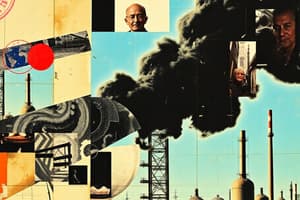Podcast
Questions and Answers
What is the primary benefit of conducting regular training sessions and emergency drills?
What is the primary benefit of conducting regular training sessions and emergency drills?
- To reduce operational costs
- To improve employee satisfaction
- To ensure compliance with federal regulations
- To identify weaknesses in emergency response plans (correct)
Which regulatory agency's requirements must organizations in the chemical engineering sector comply with?
Which regulatory agency's requirements must organizations in the chemical engineering sector comply with?
- Federal Aviation Administration (FAA)
- Occupational Safety and Health Administration (OSHA) (correct)
- National Institute of Standards and Technology (NIST)
- Environmental Protection Agency (EPA)
What role does leadership play in fostering a strong safety culture?
What role does leadership play in fostering a strong safety culture?
- Managing customer relations
- Conducting employee performance evaluations
- Prioritizing safety and providing resources (correct)
- Implementing stricter regulations
Which disaster served as a significant example of the need for improved safety measures in chemical engineering?
Which disaster served as a significant example of the need for improved safety measures in chemical engineering?
What does PSM stand for in the context of chemical engineering safety?
What does PSM stand for in the context of chemical engineering safety?
How do advancements in digital technology improve safety practices in chemical engineering?
How do advancements in digital technology improve safety practices in chemical engineering?
What is a critical component of a strong safety culture within an organization?
What is a critical component of a strong safety culture within an organization?
What is one of the main goals of implementing safety management systems?
What is one of the main goals of implementing safety management systems?
What is considered a crucial aspect of chemical engineering due to the risks involved?
What is considered a crucial aspect of chemical engineering due to the risks involved?
Which of these is NOT a common chemical hazard in chemical engineering?
Which of these is NOT a common chemical hazard in chemical engineering?
What type of control involves designing safety features into processes and equipment?
What type of control involves designing safety features into processes and equipment?
Why is personal protective equipment (PPE) important in chemical engineering?
Why is personal protective equipment (PPE) important in chemical engineering?
What is an example of an administrative control in chemical engineering?
What is an example of an administrative control in chemical engineering?
What should comprehensive emergency response plans include?
What should comprehensive emergency response plans include?
Which form of controlled safety measures focuses on policies and procedures?
Which form of controlled safety measures focuses on policies and procedures?
What is a significant consequence of not prioritizing safety in chemical engineering?
What is a significant consequence of not prioritizing safety in chemical engineering?
Flashcards are hidden until you start studying
Study Notes
Importance of Safety in Chemical Engineering
- Chemical engineering integrates various industries, leading to significant safety hazards due to chemical handling.
- Prioritizing safety is both a legal requirement and an ethical responsibility in the chemical industry.
Chemical Hazards
- Chemical hazards include toxicity, flammability, reactivity, and corrosiveness, all of which can lead to severe accidents.
- Common risks include exposure to hazardous substances, fires, explosions, and unintended chemical reactions.
Personal Protective Equipment (PPE)
- PPE is vital for minimizing exposure to chemical hazards and includes gloves, goggles, respirators, and protective clothing.
- Proper selection, utilization, and maintenance of PPE are crucial to ensure worker safety and health.
Engineering Controls
- Safety features such as ventilation systems, automated shutdown systems, and equipment isolation procedures help mitigate risks.
- Designing processes and equipment with built-in safety features is essential for preventing hazardous material releases.
Administrative Controls
- Implementation of policies, procedures, and training helps promote safe work practices within organizations.
- Risk assessments, employee safety training, emergency response protocols, and maintaining hazardous material records are key components.
Emergency Response
- Comprehensive emergency response plans minimize accident impacts and facilitate coordinated responses.
- Plans should include procedures for evacuations, medical assistance, spill containment, and communication with authorities.
- Regular training and emergency drills prepare personnel for effective crisis management and identify plan weaknesses.
Regulatory Compliance
- Adhering to regulations from organizations like OSHA and following ISO standards is mandatory in chemical engineering.
- Compliance ensures organizations meet safety benchmarks and reduce legal liabilities.
Safety Culture
- A strong safety culture is formed through collective commitment to safety across all organization levels.
- Leadership plays a critical role by prioritizing safety initiatives and modeling safe practices, while employee involvement can spark valuable safety insights.
Lessons from Past Accidents
- Analyzing past incidents like the Bhopal Gas Tragedy and the Chernobyl Disaster underscores the importance of safety measures in preventing future catastrophes.
Process Safety Management (PSM)
- PSM is a structured approach for identifying, evaluating, and controlling process hazards, ultimately aiming to prevent accidents.
- This system includes monitoring, risk assessments, and continual safety performance enhancements.
Technological Advancements
- Digital tools like sensors, data analytics, and predictive modeling revolutionize safety practices by enabling real-time process monitoring and proactive risk management.
- These innovations significantly increase overall safety performance in chemical engineering operations.
Overall Safety Significance
- Understanding chemical risks and implementing effective safety measures protect workers, communities, and the environment from potential hazards.
- Strong safety cultures within organizations can reduce the chances and impacts of accidents, promoting safer work environments.
Studying That Suits You
Use AI to generate personalized quizzes and flashcards to suit your learning preferences.




